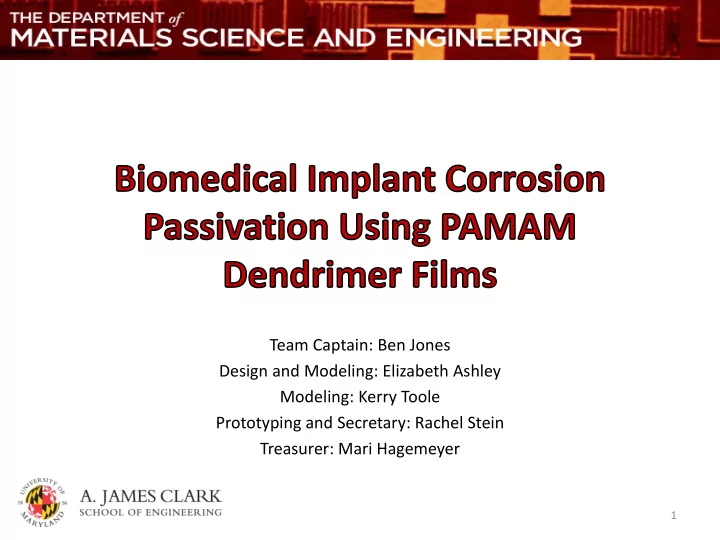

Team Captain: Ben Jones Design and Modeling: Elizabeth Ashley Modeling: Kerry Toole Prototyping and Secretary: Rachel Stein Treasurer: Mari Hagemeyer 1
• Background and Motivation • Project Design Goals • Technical Approach • Modeling Results • Prototyping • Experimental Results • Conclusion 2
• Ti/TiO 2 is widely used for biomedical implants • Passivation generally achieved by allowing the Ti to grow a native oxide layer • Problem: oxide can corrode by pitting – Driven by concentration gradients of dissolved Cl - and O 2 – Pits expose reactive Ti metal below oxide 3
• Dendrimers are fractal, branched polymers – Steric hindrance and electrostatic repulsion cause globular shape and cavities • Densely packed branches act as a diffusion barrier • PAMAM – Poly(amidoamine) 4
• Design a PAMAM dendrimer monolayer to passivate TiO 2 from pitting corrosion • Model the diffusion of chloride ions in aqueous solution through PAMAM to TiO 2 surface using Kinetic Monte Carlo • Investigate the diffusion of Ti ions from the sample through the dendrimer into a physiological solution 5
• Kinetic Monte Carlo Theory • MATLAB Simulations • Basic Approach • Limitations • Results 6
• Dendrimer film – Emulated by layered planes – Approximated as truncated cube • Cl- ion solution – Random • Total constraining volume – x*y*z 3D matrix • Boundary constraints – No particles at system edge 7
• Two basic types: orthogonal and diagonal – 36 total possible directions defined – Single- and double- hops in each basic direction 8
• Greater physical realism • Hopping probabilities determined relative to orthogonal using geometric ratios and Hooke’s Law 9
• Determine occupancy of 36 possible directions relative to ion • Assign hopping probability • Randomly select a hopping direction from available sites 10
• Time step: fs Diffused Ion Distribution 20 • Iterations: 2000 Ion Count Through Ion Count In 18 • Plot: ion 16 14 distribution per 12 Number of Ions time step 10 8 – Ions in 6 dendrimer film 4 – Ions through 2 dendrimer film 0 0 200 400 600 800 1000 1200 1400 1600 1800 2000 Time Step (fs) xyz = 40 x 40 x 20 Total ion count: 3000 11
Advantages Disadvantages • Conceptually simple • Computationally expensive • Intuitive mathematical – Impractical to simulate expression actual experimental • Scalable level of duration complexity – Must increase Cl-ion • Concise plotting features concentration for results • System “lattice”: not realistic • Dendrimers: not identical or cubic 12
Diffused Ion Distribution 40 Ion Count Through Ion Count In 35 30 25 Number of Ions 20 15 10 5 0 0 200 400 600 800 1000 1200 1400 1600 1800 2000 Time Step (fs) 13
• Sputtering and Oxidation • Dendrimer Film Formation • Corrosion Testing • Ellipsometry • SEM/EDS • ICP-OES • Data Analysis 14
• Required: prototype surface smooth enough for characterization – Sputtered ~ 1 μ m Ti metal onto Si substrate • Two oxidation techniques: – Thermal: heat samples in an oven under O 2 gas at 700 ⁰C for 1 hour – Plasma-enhanced: bombard samples with O 2 plasma at 400 ⁰C for 2 minutes 15
Fabrication procedure Corrosion Testing • 0.39 μ m G5 PAMAM • Simulate physiological dendrimer in methanol conditions • Submerge titanium • Ringer’s solution: oxide surfaces in – Salts: NaCl, KCl, CaCl 2 solution for 2 hours – pH ~ 7 with agitation – T : 37 ⁰C • Allow samples to air dry – t : 120 hr (5 days) in fume hood 16
• Polarized light is reflected from sample surface • Polarization, incident and reflected angles, and light intensity are measured • Material indices of refraction and absorbances are used to determine layer thickness 17
• S canning E lectron M icroscopy, E nergy- D ispersive X-Ray S pectroscopy • We can only indirectly detect dendrimers via C,N, and O on the surface of our devices • Based on EDS intensities more dendrimers correspond to higher Cl concentration • This supports our simulations showing ions trapped in the dendrimer layer 18
• I nductively C oupled Ti Ion Concentration after Incubation in P lasma O ptical Ringer's Solution 0.6 E mission S pectroscopy Bare PAMAM-coated 0.5 • Solution is ionized, Ti Ion Conentration (ng/L) 0.4 emitting a signature 0.3 light spectra 0.2 – Ppb resolution possible 0.1 • Quantitative data 0 requires formation of a Titanium Plasma Oxidized Thermal Oxidized standard curve in appropriate matrix 19
• PAMAM monolayer decreases chloride ion diffusion into oxide by trapping the ions • Ions diffuse into control oxide at a constant rate while ions cannot diffuse through dendrimers • Overall: dendrimers can decrease pitting corrosion of titanium by trapping anions 20
• Design Work – More iterations; better memory allocation • Prototype Work – XPS characterization to quantitatively study Cl concentration after testing – EIS to study corrosion rate and possible pinholes – Study delamination; consider covalently bound dendrimers using polyethyleneglycol 21
Recommend
More recommend